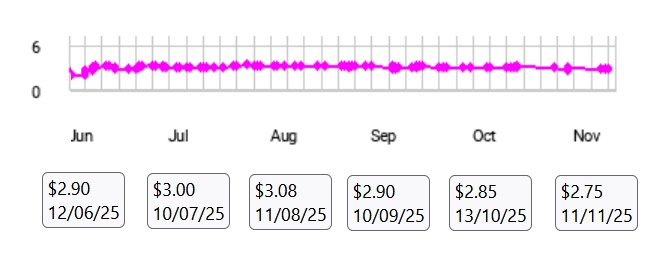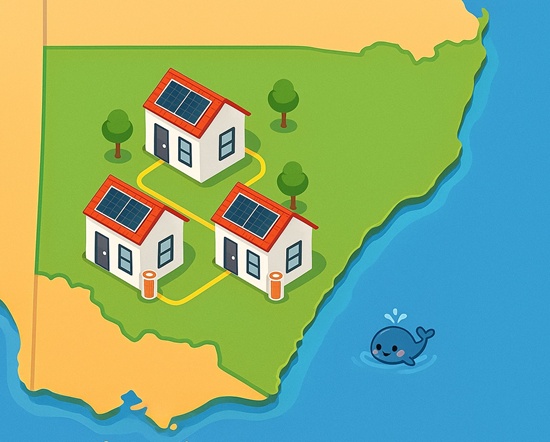How To Get NSW’s Virtual Power Plant Incentive
Last Updated: 24th Nov 2025
NSW homes and small businesses can receive a payment for connecting their batteries to a Virtual Power Plant (VPP). It can be combined with the federal battery rebate and doesn’t affect the payments VPPs normally provide. To get it, a battery can’t have more than 28 kilowatt-hours (kWh) of usable capacity, but to get the federal battery rebate, it must have at least 5kWh, so a battery will need from 5-28kWh to benefit from both.
At the time of writing, the total payment is around $60 per kilowatt-hour (kWh) or $1,200 for a 20kWh battery — but households only receive around 60% of this amount. In November 2025, typical payments to households were around $36 per kWh or $720 for a 20kWh battery.
VPP Payment Eligibility
Details can be found on the NSW government page on the incentive, but here are the main eligibility requirements:
- The battery must have from 2-28kWh of usable storage — but must have at least 5kWh of usable storage to also receive the federal battery rebate.
- The battery must be on CEC approved battery list and eligible to receive the federal battery rebate.
- No battery on the property can have already received this payment or the earlier NSW VPP payment available before July 1, 2025.
- If the battery isn’t new it must have at least six years warranty remaining — note some older batteries such as the Powerwall 2 are no longer on the CEC approved battery list and so aren’t eligible, regardless of remaining warranty.
- The property must have solar.
- No one can be on life-support.
- You have to be on-grid, as off-grid batteries can’t join VPPs.
- The property must be in NSW (duh).
The NSW government also provides this checklist, which will be a little confusing for some people. But if your battery is new and received the federal battery rebate, it should qualify to receive the NSW VPP incentive. If you contact the VPP provider you are interested in joining, they’ll be able to help you. It’s also possible your battery installer will offer to help you sign up to a VPP and get the incentive.
A few points to keep in mind:
Battery capacity: While the VPP incentive is strictly for batteries with 2-28kWh of usable capacity, the federal battery rebate can only be used by batteries with at least 5kWh of usable capacity. This means to get both the battery capacity must be from 5-28kWh without going over. It’s okay to have multiple batteries, provided their total capacity is within that limit.
Make sure there’s a VPP your battery can join: If you are getting a new battery and there’s a VPP you want to join, make sure they accept the battery intend to get. If there’s no VPP in your area that accepts your battery, it won’t be possible to get the incentive.
Older batteries can become ineligible: Batteries must be on the CEC approved battery list. If a manufacturer allows their listing to expire, the battery won’t be able to receive the VPP incentive, regardless of how much warranty it has remaining. This has already happened to the Tesla Powerwall 2. You can check the CEC approved battery list to see when listings are set to expire. Companies rarely renew older models because doing so costs over $6,000.
How The Scheme Works
The VPP payment is part of the NSW Peak Demand Reduction Scheme which is designed to reduce strain on the grid and reduce costs by improving how efficiently it works. Batteries joining a VPP help and so can receive a payment. But it’s not a straightforward process.
When a home battery joins a VPP, this creates Peak Reduction Certificates (PRCs), which can be traded for money. But only certain companies, called Accredited Certificate Providers (ACPs) can create them. Also, the certificates don’t go to the homeowner. The ACP gets them, trades them for money, and then passes on to the homeowner what’s left after they take a share. In practice, households get roughly 60% of what the certificates’ market value.
The number of certificates created mainly depends on the size of the battery, but can also be affected by location. You can get an estimate of the number of certificates a battery will receive using this NSW government calculator.
In November 2025, the number of certificates received in the middle of Sydney is around 22 per usable kWh. Each certificate was worth around $2.75 at that time, but their value can change, as this graph shows:

PRC prices can head up or down. You can track their value on Demand Manager.
In past years, they have gone as low as $1, while at other times they’ve gone over $3.
Why Do Households Get So Little Of The Incentive?
With these types of incentive schemes, there are always administration costs. However, they don’t have to be around 40% of the incentive. The federal solar rebate admin costs are only roughly 10%. It’s like the NSW VPP incentive was designed by someone who had studied Economics 101, but they were away for the “1” on the end and missed half the “0” in the middle. Hopefully, the NSW government will act to stem this waste — potentially by offering the incentive directly to households — but at this time, we’ve seen no indication they intend to take action.
Former NSW VPP Payment & Battery Incentive No Longer Available
The NSW government used to provide a slightly different VPP payment and a battery incentive before July 1, 2025. These are no longer available.
The battery incentive was dropped when the federal battery rebate became available, while the VPP payment consisted of two separate payments, rather than the single one available now. If the old VPP payment was received, you won’t be able to get the new one.
Next Steps – Start Now
If you are looking to get a home battery in NSW, simply request a battery quote. We’ll then match you to up to 3 trusted installers servicing your area who will provide you with a detailed obligation-free quote for a system that best suits your needs and circumstances.
If you need more information to determine if a home energy storage is right for you, check out our detailed guides to understanding, buying and owning a solar battery, and also our guide to Virtual Power Plants.
